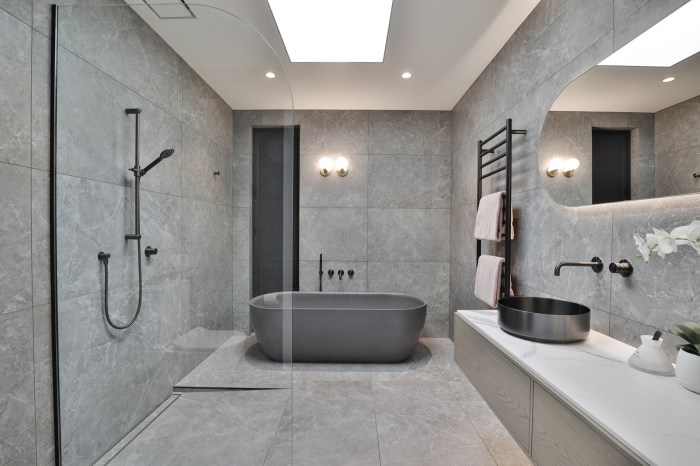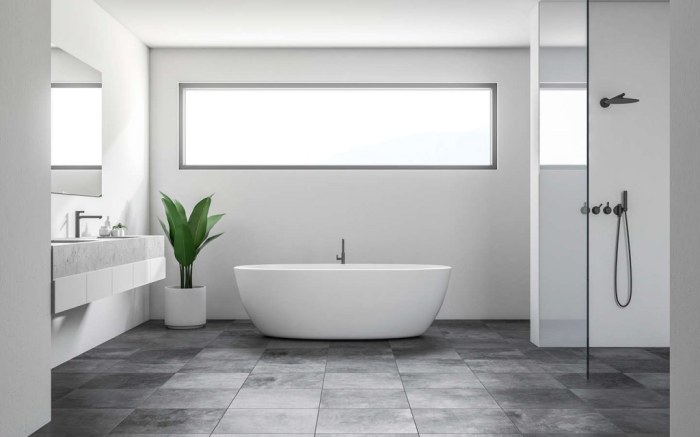In the realm of bathroom design, hygiene takes center stage. Antimicrobial bathroom floor tiles have emerged as a revolutionary solution, offering an unparalleled level of protection against harmful bacteria and microorganisms. Join us as we delve into the world of antimicrobial bathroom floor tiles, exploring their benefits, considerations, and design possibilities.
Let’s create a bathroom that is not only aesthetically pleasing but also a sanctuary of cleanliness.
Antimicrobial floor tiles are infused with special properties that actively inhibit the growth and spread of bacteria, mold, and other microbes. This remarkable feature ensures a cleaner, healthier bathroom environment, reducing the risk of infections and promoting overall well-being.
Overview of Bathroom Floor Tiles with Antimicrobial Properties
Bathroom floor tiles with antimicrobial properties provide an effective solution for maintaining a hygienic and healthy bathroom environment. These tiles are infused with antimicrobial agents that inhibit the growth and proliferation of microorganisms, such as bacteria, mold, and fungi, creating a cleaner and safer space.
Types of Antimicrobial Properties
Various types of antimicrobial properties can be incorporated into bathroom floor tiles:
- Silver Ion Technology: Silver ions have strong antimicrobial properties and can effectively inhibit the growth of a wide range of microorganisms.
- Copper-Based Compounds: Copper is another effective antimicrobial agent that can be added to floor tiles to prevent the spread of bacteria and fungi.
- Photocatalytic Materials: These materials, such as titanium dioxide, use ultraviolet light to generate reactive oxygen species that can destroy microorganisms.
Materials Used for Antimicrobial Floor Tiles
Antimicrobial bathroom floor tiles can be made from various materials, including:
- Ceramic Tiles: Ceramic tiles are a popular choice for bathroom floors due to their durability, ease of maintenance, and ability to incorporate antimicrobial properties.
- Porcelain Tiles: Porcelain tiles are a more durable and non-porous option than ceramic tiles, making them highly resistant to moisture and microbial growth.
- Glass Tiles: Glass tiles are non-porous and can be infused with antimicrobial agents to create a hygienic and stylish bathroom floor.
Advantages and Disadvantages of Antimicrobial Bathroom Floor Tiles
Antimicrobial bathroom floor tiles offer several advantages and disadvantages compared to traditional tiles. Understanding these aspects can help homeowners make informed decisions when choosing bathroom flooring.
Let’s explore the key advantages and disadvantages to consider:
Advantages
- Enhanced Hygiene: Antimicrobial tiles effectively reduce the growth and spread of bacteria, mold, and other microorganisms on the bathroom floor, promoting a cleaner and healthier environment.
- Odor Control: The antimicrobial properties help eliminate unpleasant odors caused by bacteria and mold, ensuring a fresher and more pleasant bathroom atmosphere.
- Durability: Antimicrobial tiles are typically made from durable materials, such as porcelain or ceramic, making them resistant to wear, scratches, and stains.
- Low Maintenance: These tiles require less frequent cleaning and maintenance compared to traditional tiles, as the antimicrobial properties inhibit the buildup of dirt and grime.
Disadvantages
- Higher Cost: Antimicrobial bathroom floor tiles tend to be more expensive than traditional tiles due to the added antimicrobial treatment.
- Limited Design Options: While antimicrobial tiles are available in various colors and styles, the selection may be more limited compared to traditional tiles.
- Potential Chemical Exposure: Some antimicrobial treatments may release chemicals that can be harmful to humans and the environment, although this varies depending on the specific treatment used.
When comparing the advantages and disadvantages, it’s important to consider the specific needs and preferences of homeowners. For those prioritizing hygiene and low maintenance, antimicrobial bathroom floor tiles offer significant benefits. However, if cost and design flexibility are primary concerns, traditional tiles may be a more suitable choice.
Considerations for Choosing Antimicrobial Bathroom Floor Tiles
Selecting antimicrobial bathroom floor tiles requires careful consideration of several key factors to ensure they meet your specific needs and provide long-lasting performance.
Durability: Antimicrobial floor tiles should be resistant to wear, scratches, and impacts to withstand the daily rigors of bathroom use. Consider tiles with a high Mohs hardness rating for enhanced durability.
Maintenance: Tiles with antimicrobial properties can reduce the growth of bacteria and mold, but they still require regular cleaning. Choose tiles with a smooth, non-porous surface that is easy to wipe down and maintain.
Cost: Antimicrobial floor tiles can be more expensive than traditional tiles. Determine your budget and consider the long-term benefits of reduced maintenance and improved hygiene.
Style and Design: Antimicrobial floor tiles are available in a wide range of colors, patterns, and textures. Select tiles that complement the overall design of your bathroom and personal preferences.
Specific Needs
Consider your specific bathroom needs when choosing antimicrobial floor tiles:
- High-traffic areas: Choose tiles with high durability and slip resistance for areas with frequent foot traffic.
- Wet areas: Opt for tiles with low water absorption and a non-slip surface to prevent accidents.
- Health concerns: If you have allergies or respiratory issues, consider tiles with antimicrobial properties to reduce the risk of infections.
Installation and Maintenance of Antimicrobial Bathroom Floor Tiles
Installing and maintaining antimicrobial bathroom floor tiles ensures their optimal performance and longevity. Proper installation and care techniques are crucial for maximizing the tiles’ hygiene benefits and preserving their appearance.
Follow these steps for successful installation:
Step-by-Step Installation Guide
- Prepare the subfloor by ensuring it is level, dry, and free of debris.
- Apply a layer of thin-set mortar to the subfloor using a notched trowel.
- Place the antimicrobial floor tiles onto the thin-set mortar, pressing firmly to ensure good adhesion.
- Use spacers to maintain uniform grout lines between the tiles.
- Allow the thin-set mortar to dry completely before grouting.
- Apply grout to the joints between the tiles using a grout float.
- Remove excess grout with a damp sponge and let it dry.
- Seal the grout with a penetrating sealer to prevent moisture penetration.
To maintain antimicrobial bathroom floor tiles, follow these techniques:
Proper Maintenance Techniques
- Sweep or vacuum regularly to remove dirt and debris.
- Mop with a mild detergent solution, avoiding harsh chemicals.
- Use a soft brush or cloth to clean grout lines, preventing damage.
- Avoid using abrasive cleaners or scrubbing pads that can scratch the tiles.
- Apply a tile sealer periodically to maintain the protective layer and enhance durability.
By adhering to these installation and maintenance guidelines, you can ensure the effectiveness and longevity of your antimicrobial bathroom floor tiles, promoting a hygienic and aesthetically pleasing bathroom environment.
Design Ideas for Antimicrobial Bathroom Floor Tiles
Incorporating antimicrobial bathroom floor tiles opens up a world of design possibilities to elevate the aesthetic appeal of your bathroom. From classic to contemporary, there’s a myriad of styles to complement any decor.
These tiles come in a diverse range of patterns, colors, and textures, allowing you to create a truly unique space. Whether you prefer the timeless elegance of marble-look tiles, the earthy charm of stone-effect tiles, or the bold geometric patterns of mosaic tiles, there’s an antimicrobial option to suit your taste.
Patterns
Experiment with different patterns to add visual interest to your bathroom floor. Classic checkerboard patterns, herringbone designs, and intricate geometric motifs can create a striking focal point. Alternatively, opt for a more subtle approach with linear patterns or random tile arrangements for a contemporary look.
Colors
The color of your antimicrobial bathroom floor tiles plays a significant role in setting the overall tone of the space. Neutral shades like white, gray, and beige create a clean and airy atmosphere, while bolder hues like blue, green, or black add a touch of drama.
Consider the existing color scheme of your bathroom and choose a tile color that complements or contrasts it effectively.
Textures
The texture of your antimicrobial bathroom floor tiles can enhance the overall design aesthetic. Smooth, polished tiles reflect light and create a sleek, modern look, while textured tiles add depth and interest to the space. Consider using a combination of textures to create a dynamic and visually appealing floor.
Final Thoughts
As we conclude our exploration of antimicrobial bathroom floor tiles, it is evident that these tiles offer a multitude of advantages. Their ability to combat bacteria and promote hygiene makes them an indispensable choice for modern bathrooms. By carefully considering factors such as durability, maintenance, and cost, you can select the perfect antimicrobial floor tiles to elevate your bathroom’s aesthetic while safeguarding your health.
Embrace the future of bathroom design with antimicrobial floor tiles and enjoy a germ-free, stylish sanctuary for years to come.



